Yamaha XS6-MOTIF, XS7-MOTIF, XS8- MOTIF User Manual

MOTIF XS Editor Owner’s Manual
Contents |
|
What is the MOTIF XS Editor?................................................. |
2 |
Studio Manager ........................................................................ |
2 |
Studio Connections ................................................................. |
2 |
About Open Plug-in Technology ............................................. |
3 |
MOTIF XS Editor File ................................................................ |
4 |
Starting the MOTIF XS Editor .................................................. |
5 |
An Example of MOTIF XS Editor in Use ................................. |
6 |
MOTIF XS Editor Window....................................................... |
10 |
Basic Operations.................................................................... |
23 |
Menu ........................................................................................ |
25 |
Troubleshooting ..................................................................... |
38 |
•Copying of the commercially available music sequence data and/or digital audio files is strictly prohibited except for your personal use.
•The software and this owner’s manual are exclusive copyrights of Yamaha Corporation.
•Copying of the software or reproduction of this manual in whole or in part by any means is expressly forbidden without the written consent of the manufacturer.
•Yamaha makes no representations or warranties with regard to the use of the software and documentation and cannot be held responsible for the results of the use of this manual and the software.
•The screen displays as illustrated in this Owner’s Manual are for instructional purposes, and may appear somewhat different from the screens which appear on your computer.
•The company names and product names in this Owner’s Manual are the trademarks or registered trademarks of their respective companies.
•Click on the red-colored text to jump to the related item in this manual.
This owner’s manual assumes that you are already familiar with basic Windows/Macintosh operations. If you are not, please refer to the owner’s manual which came with your Windows/Macintosh software before using the MOTIF XS Editor.
For information about hardware requirements, the interconnection of devices and the installation of the MOTIF XS Editor software, refer to the separate Installation Manual as well as the Owner’s Manual for the respective MIDI device.
© 2007 Yamaha Corporation. All rights reserved.
MOTIF XS Editor Owner’s Manual |
1 |
|
|

What is the MOTIF XS Editor?
What is the MOTIF XS Editor?
MOTIF XS Editor is a convenient tool which lets you edit and save the various parameters of your MOTIF XS synthesizer. These include Common/Part Mixing parameters (edited in the Song or Pattern mode of the MOTIF XS) such as Volume, Pan, EG, and Cutoff and parameters of a Voice assigned to each Part (edited in the Voice mode of the MOTIF XS). Thanks to its the easy-to-understand graphical interface, you can edit various parameters of the MOTIF XS right from your computer—using the mouse to adjust the virtual knobs, sliders, and buttons and entering values from the computer keyboard. Finally, all the changes you have made can be saved to your computer or transmitted to the MOTIF XS instrument.
You can use this MOTIF XS Editor as a plug-in for the software below.
•Studio Manager
•DAW application software compatible with Studio Connections
Studio Manager
Studio Manager V2 is a cross-platform application that enables you to start multiple Editors for controlling Yamaha hardware products remotely, and to save multiple Editor settings. You can run Studio Manager as a stand-alone application, or as a plug-in within DAW applications compatible with Studio Connections such as Cubase 4.
For more information, refer to the Studio Manager PDF manual.
Studio Connections
Studio Connections is a joint project begun by Steinberg and Yamaha. Music production systems now increasingly rely on both software and hardware, and there is a pressing need for closer integration between the two. Studio Connections provides a comprehensive and seamless music production environment—making the use of hardware and software both easier and much more efficient. The following functions are available in Studio Connections.
Recall
With the Recall function, all settings in each Editor can be saved within Studio Manager, and then called up again when needed. This enables you to recall all the settings of multiple devices from Studio Manager and control the entire system easily, instantly and automatically.
When executing the Recall function in the Studio Manager, the parameter settings of either device (MOTIF XS or DAW software on a computer) are synchronized with the other. You can determine which device (MOTIF XS or DAW software) is regarded as the master of the parameter settings by setting the Auto Sync Setting (page 28).
Recall is especially convenient when used with a DAW application compatible with Studio Connections. This lets you save the Editor data directly to the project file of the DAW letting you recall all necessary hardware settings automatically by simply opening the project file.
MOTIF XS Editor Owner’s Manual |
2 |
|
|
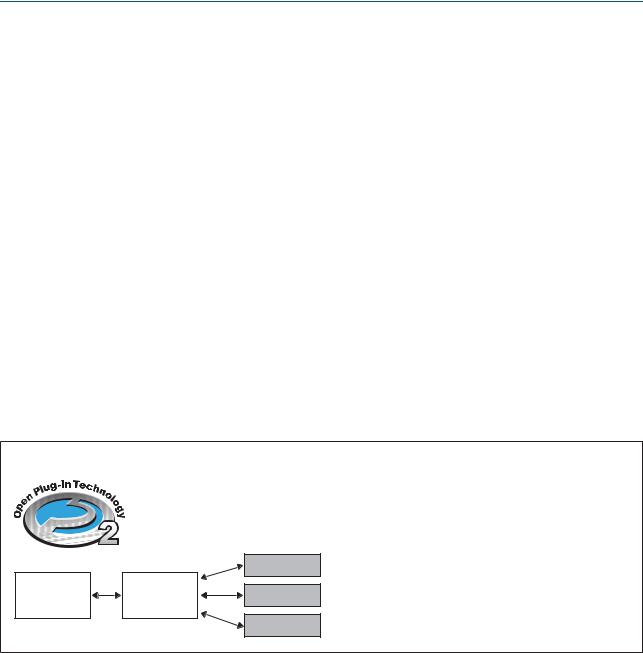
About Open Plug-in Technology
Audio Integration
Plug-in software such as software synthesizers and software samplers are exceptionally convenient in that they let you easily change the various settings and parameters within the host application. However, control over hardware is not so easy—with the need for various setups such as audio connections, driver settings and MIDI port connections.
By using the DAW software compatible with Studio Connections, you can control the external hardware synthesizer within the application, without the need to set up complex connections within a DAW software application—just as easily and conveniently as you would with plug-in software. The Audio Integration function makes all this possible. For details about Recall and Audio Integration, visit our web site at:
http://www.studioconnections.org/
About Open Plug-in Technology
Open Plug-in Technology (OPT) is a software format that enables you to control MIDI devices from a music DAW application software. For example, this allows you to start up and operate various parts of your music system, such as voice editors of the synthesizer and mixing control editors—directly from an OPT-compatible software, without having to use each separately. OPT also makes it unnecessary to set MIDI drivers for each application, streamlining your music production system and making all operations more convenient and seamless.
In addition to the original OPT, Open Plug-in Technology Version 2 (OPT 2), designed for Studio Connections, is also available. The host application Studio Manager supports OPT 2.
About the OPT 2 Overview
OPT 2 is a plug-in format that enhances OPT Level 1 (Panels) and adds some convenient functions for Studio Connections.
Editor
Host |
Studio |
OPT2 |
|
Editor |
|||
Application |
Manager |
||
|
Editor
Plug-in software compatible with OPT 2 is indirectly connected to the DAW application compatible with Studio Connection, via the Studio Manager.
MOTIF XS Editor Owner’s Manual |
3 |
|
|
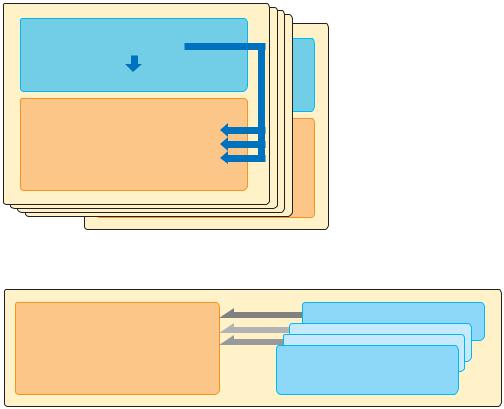
MOTIF XS Editor File
MOTIF XS Editor File
The MOTIF XS Editor lets you create the following data and save them as a single file (extension: X0E).
•Current settings (consisting of Mixing setup, latest status of edited Voice and 16 Mixing Voices)
•User Voice data (consisting of three Normal Voice Banks and one Drum Voice Bank)
Current settings includes the latest settings of the Common and Element parameters for the Voice last assigned to each of Parts 1 – 16, as well as Mixing parameter settings such as Voice assignment, pan, volume and effect for each Part. Among the Voice Banks, only the Mixing Voice Bank data belongs to the Current settings. The MOTIF XS Editor lets you edit parameters (including Element parameters) of the Voice assigned to each Part and save the latest edit status as a file without storing it as a User Voice or a Mixing Voice. This means that you can easily recall the latest status of the previous edit simply by opening the file.
User Voice data has the same Bank structure as that on the MOTIF XS itself. If you store the edited Voice assigned to each Part to one of the Voice Banks, the stored Voice can be saved as a file.
nYou can edit both the Element and Common parameters of the assigned Normal Voice and store them as a User Normal Voice or Mixing Voice. Keep in mind that Drum Voice parameters cannot be edited even if a Drum Voice is assigned to a Part.
Memory structure of a MOTIF XS Editor file (extension: .X0E)
Current settings (for a Song or Pattern)
• Mixing setup (Multi setup)
Store
• 16 Mixing Voices
User Voice data |
Store |
•User Bank 1 (128 Normal Voices)
•User Bank 2 (128 Normal Voices)
•User Bank 3 (128 Normal Voices)
•User Drum Bank (32 Drum Voices)*
In addition to the current settings for a certain Song or Pattern, all User Voices and Mixing Voices are contained in each file of the MOTIF XS Editor.
*The User Drum Voice Bank can be edited by rearranging the order of Drum Voices or copying the preset Drum Voice(s) to this Bank or receiving the User Drum Voice data from the MOTIF XS, even though the Drum Voice itself cannot be edited on the MOTIF XS Editor.
Memory structure of the MOTIF XS
User Voice data
•User Bank 1 (128 Normal Voices)
•User Bank 2 (128 Normal Voices)
•User Bank 3 (128 Normal Voices)
•User Drum Bank (32 Drum Voices)
Song 64
 Song 1
Song 1
•Mixing setup (Multi setup)
•16 Mixing Voices
On the MOTIF XS, one set of User Voice data is used in common for all Songs or Patterns, meaning that the Mixing setup for each Song or Pattern does not have its own User Voice data.
MOTIF XS Editor Owner’s Manual |
4 |
|
|

Starting the MOTIF XS Editor
Starting the MOTIF XS Editor
Install the driver (USB-MIDI driver or mLAN driver), Studio Manager and MOTIF XS Editor by following the respective Installation Guides, then install the host application such as Cubase if necessary. After making the required connection and set the MIDI IN/OUT parameter to “USB” or “mLAN” in the Utility mode, follow the instructions below to start the MOTIF XS Editor.
n For details about connection between the MOTIF XS and a computer, refer to the Owner’s Manual of the MOTIF XS.
n Make sure to set the MIDI IN/OUT parameter ([UTILITY] → [F5] Control → [SF2] MIDI) in the Utility mode of the MOTIF XS to the appropriate value. If you are using a USB cable for connection, this parameter should be set to “USB”; if you are using an mLAN cable, this should be set to “mLAN.”
1.Start the Studio Manager.
Studio Manager can be started as a plug-in within a Studio Connections-compatible DAW software, or can be started as a stand-alone application.
2.Set the MIDI Ports.
When starting Studio Manager as a stand-alone application:
Set the MIDI Ports by calling up the MIDI Ports window via [File] → [Setup] → [MIDI Ports]. When the connection is done via a USB cable, enter the checkmarks to the boxes of Ports 1 and 4 for the MOTIF XS in both the Input Ports and the Output Ports, as illustrated below. When the connection is done via an IEEE1394 cable, enter the checkmark to the boxes of the Ports corresponding to the mLAN Port 1 of the MOTIF XS in both the Input Ports and the Output Ports.
When starting Studio Manager as a plug-in of the DAW application:
Set the MIDI Ports on the DAW application. For details, refer to the manual of the DAW application. When connecting the MOTIF XS to a computer via a USB cable, the MIDI Ports are automatically set simply by starting Studio Manager from Cubase 4. This is also true when connecting the MOTIF XS to a computer via an IEEE1394 cable and installing “Extensions for Steinberg DAW” to the computer.
3.Start the MOTIF XS Editor from the window of the Studio Manager.
For details, refer to the Installation Guide and the PDF manual of the Studio Manager.
When using Studio Manager as a plug-in with the Audio Integration features of Studio Connections (within a compatible DAW), you can start the MOTIF XS Editor just as you would any other software synthesizer. For details, visit the following web site.
http://www.studioconnections.org/
MOTIF XS Editor Owner’s Manual |
5 |
|
|
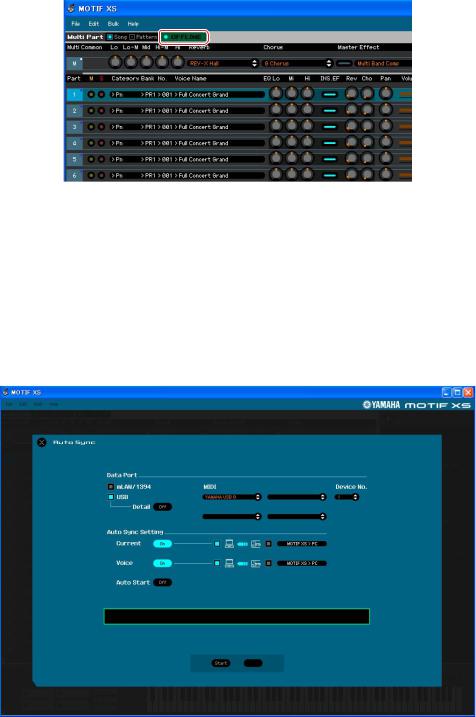
An Example of MOTIF XS Editor in Use
An Example of MOTIF XS Editor in Use
There is no single way to use the many components in the MOTIF XS Editor. Your editing needs and preferences may differ; however, the following example gives you a simple step-by-step guide in how to use the MOTIF XS Editor.
Steps 1 – 4 below cover how to set the MOTIF XS Editor to “ONLINE” status which enables you synchronize the settings on the MOTIF XS instrument with those on the MOTIF XS Editor. Steps 5 – 8 then describe by example specifically how to use this Editor.
1.After starting the MOTIF XS Editor, select “Song” or “Pattern” then click “OFFLINE” to open the Auto Sync window.
2.From the Auto Sync window, set communication-related parameters such as Input Port, Output Port and Device Number in the Data Port section, then set the direction of Data Auto Synchronization (Current and Voice) in the Auto Sync Setting section.
When you want to use the settings on the MOTIF XS itself as starting data for editing, set Current and Voice in the Auto Sync Setting so that the arrow indicates data flow from the keyboard to the computer. To use the settings on the MOTIF XS Editor as starting data, set both Current and Voice to the opposite, so that the arrow indicates data flow from the computer to the keyboard. For details, see page 27.
MOTIF XS Editor Owner’s Manual |
6 |
|
|
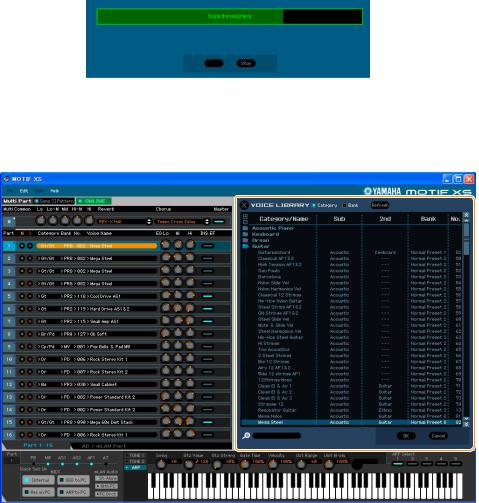
An Example of MOTIF XS Editor in Use
 CAUTION
CAUTION
Keep in mind that when you set Voice to On, enable data sync from the computer to the MOTIF XS (keyboard), and then click the [Start] button at the bottom, this operation transmits User Voice data currently on the Editor to the MOTIF XS itself, automatically overwriting and erasing all User Voices already existing on memory of the MOTIF XS instrument, regardless of the currently selected Song or Pattern. Make sure to save the User Voice data on the MOTIF XS instrument to a separate memory device like a USB storage device before using the MOTIF XS Editor.
3. On the MOTIF XS, select the desired number of a Song or Pattern to be edited.
nPlease keep in mind that you can use the MOTIF XS Editor when the connected MOTIF XS instrument is in the Song mode or Pattern mode. If the MOTIF XS Editor is in the ONLINE status and the MOTIF XS is in any of the other modes such as Voice mode and Performance mode, executing the Auto Sync in step 4 automatically sets the mode to Song or Pattern according to the Multi Part setting (page 10). If you want to change the mode from Song to Pattern and vice versa while editing, set the Multi Part mode (page 10).
 CAUTION
CAUTION
Do not change the Song number or Pattern number before saving the current editing as a MOTIF XS Editor file or storing the Song or Pattern data to internal memory of the MOTIF XS. This results in the loss of the settings you’ve made.
4.On the MOTIF XS Editor, click [Start] at the bottom of the Auto Sync window.
The data synchronization will be started if the Port settings are correct. As soon as the data synchronization is completed, the Auto Sync window is closed, then the OFFLINE indication is changed to the ONLINE indication automatically. In this ONLINE status, editing a parameter on the MOTIF XS Editor affects the same parameter on the MOTIF XS itself, and vice versa.
5.Select a Voice for each part.
5-1 Click the Bank name or Voice name for each part to call up the VOICE LIBRARY window.
MOTIF XS Editor Owner’s Manual |
7 |
|
|
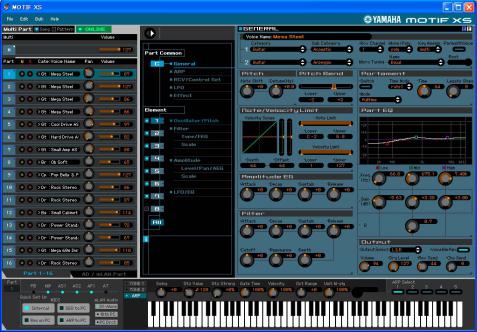
An Example of MOTIF XS Editor in Use
5-2 From the list in the VOICE LIBRARY, select the desired Voice to assign it temporarily to the current Part.
nHere, you can cancel this operation by clicking the Close (X) button or [Cancel] button at bottom right of the window. By executing this operation, the Voice assignment is reset to the original status and the VOICE LIBRARY window closes.
 CAUTION
CAUTION
When the Voice assigned to the current Part is changed to the different one, your edits of the Voice previously assigned to the Part will be lost. If you want to store the edits, make sure to store the Voice by using the Store window (page 33) before changing the Voice.
5-3 Click [OK] at bottom right of the window to actually assign the selected Voice to the current Part and close the VOICE LIBRARY window.
6.Edit parameters as desired.
When you click and highlight the “M” box at the top left of the window, you can edit the Mixing Common parameters (page 11) lined up to the right of “M.” When clicking the desired Part number from 1 – 16, you can edit Mixing Part parameters (page 11) lined at right of the Voice name for the selected part. Furthermore, you can make detailed settings of the selected Part by clicking the arrow button at the top of the right panel next to the main window to call up the Detailed Parameter section. For details, see page 18.
nOnly the Mixing related parameters can be edited when a Drum Voice is assigned to the current Part, while the Voice Element parameters as well as Mixing parameters can be edited when a Normal Voice is assigned to the current Part.
MOTIF XS Editor Owner’s Manual |
8 |
|
|

An Example of MOTIF XS Editor in Use
7. Store the edited settings as a User Voice or a Mixing Voice, as necessary.
n Only Normal Voices can be stored; Drum Voices cannot be stored.
7-1 Click [Store] under [Edit] in the menu bar to open the Store window (page 33).
7-2 Select a Voice Bank from the following list:
•Normal User 1
•Normal User 2
•Normal User 3
•Mixing
7-3 Open the selected Bank, select the desired number as destination, then enter the name of the Voice in the box at the top of this window.
7-4 Click [Store] to store the edited Voice to the selected number in the selected Bank.
 CAUTION
CAUTION
When you execute the Store operation, the settings for the destination memory will be overwritten. Select the destination Voice number carefully to prevent important data from being erased accidentally.
8.Save the edited data.
Click [Save] or [Save As] under [File] in the menu bar then save the edited data as a file (extension:
.X0E). When you want to use the edited data, open the saved file, click [Data Sync] under [Bulk] in the menu bar to open the Data Sync window (page 35), then execute the Transmit operation.
•When starting the MOTIF XS Editor from Studio Manager, you can save the MOTIF XS Editor data into the Session file of Studio Manager.
•When using DAW (digital audio workstation) software compatible with Studio Connections and the Studio Manager together, the MOTIF XS Editor data can be saved into the Project file of the DAW.
MOTIF XS Editor Owner’s Manual |
9 |
|
|
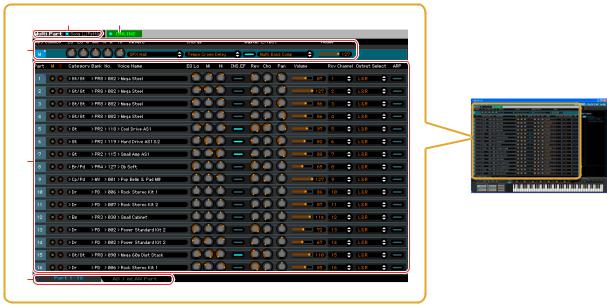
MOTIF XS Editor Window: Mixer section
MOTIF XS Editor Window
Mixer section
This section lets you edit the Mixing parameters.
12
3
5
4
1Multi Part mode
Determines the mode of the MOTIF XS, Song or Pattern. As soon as “Song” or “Pattern” is selected here, the mode of the MOTIF XS instrument changes accordingly and the Auto Sync window (page 36) opens. After setting parameters as necessary on this window, click [Start] to execute data synchronization between the MOTIF XS Editor and the MOTIF XS instrument.
2ONLINE/OFFLINE
Clicking this switches the status of the Editor between “ONLINE” and “OFFLINE.” When “ONLINE” is indicated, the edited status is completely synchronized between the MOTIF XS Editor and the MOTIF XS instrument, meaning that editing a parameter on the MOTIF XS Editor affects the same parameter on the MOTIF XS instrument and vice versa. When OFFLINE is selected, editing on the MOTIF XS Editor will not affect the MOTIF XS instrument and vice versa even if the MOTIF XS instrument is connected to a computer.
Note that the indication here is automatically changed according to the status of communication between the MOTIF XS Editor and the MOTIF XS instrument. For example, the ONLINE status is changed to OFFLINE status automatically when the cable is disconnected accidentally.
1 
Indicates that the current status is set to ONLINE. Clicking this calls up OFFLINE (2) described below. Keep in mind that ONLINE indication cannot be called up when the MIDI Port is not set properly or the MOTIF XS instrument is not properly connected to a computer.
2 
This OFFLINE indication shows that the MIDI Port is set properly and the MOTIF XS is properly connected to a computer. Clicking this calls up the Auto Sync window. From the Auto Sync window, you can synchronize the settings between the MOTIF XS Editor and the MOTIF XS by clicking the [Start] button. As soon as data synchronization is completed, the Auto Sync window is closed and the status of the Editor changes from OFFLINE to ONLINE.
nWhen both the Current and Voice settings are set to “Off” and Auto Start is set to “On” in the Auto Sync window, clicking here changes the Editor status from OFFLINE to ONLINE without opening the Auto Sync window.
MOTIF XS Editor Owner’s Manual |
10 |
|
|
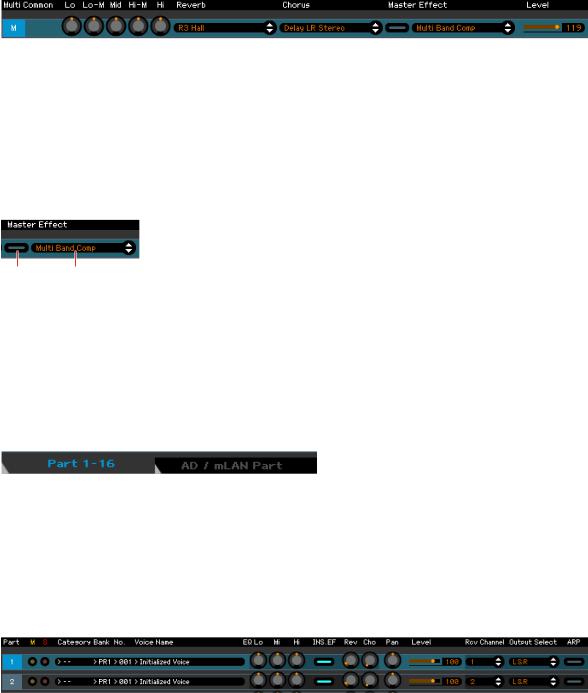
MOTIF XS Editor Window: Mixer section
3 
This OFFLINE indication shows that the MIDI Port is not set properly or the MOTIF XS instrument is not connected to a computer properly. Clicking this calls up the Auto Sync window. After making sure to connect the MOTIF XS instrument to a computer, set the MIDI Port properly then click [Start] button in the Auto Sync window to execute data synchronization between the MOTIF XS Editor and the MOTIF XS instrument. As soon as data synchronization is completed, the Auto Sync window is closed and the status of the Editor is changed from OFFLINE to ONLINE.
3Multi Common
This control strip lets you edit the Mixing Common parameters for all Parts. Clicking “M” turns this section on as illustrated below.
nWhen editing any of the Mixing parameters described below or any of the Mixing Part parameters, a small square appears at the top right of the “M” box until you save the edited data as a file. This indication is equivalent to the white [E] indicator (page 18).
Lo, Lo-M, Mid, Hi-M, Hi (Master EQ)
Edits the Master EQ parameters.
Reverb
Selects the Reverb type.
Chorus
Selects the Chorus type.
Master Effect
12
1 Turns the Master Effect on or off.
2 Selects the Master Effect type.
Level (Master Volume Level)
Adjusts the Master Volume Level.
4[Parts 1 – 16]/[AD/mLAN Parts] tab
Selects the Parts to be edited from [Parts 1 – 16] and [AD/mLAN Parts]. The illustration below indicates that the [Parts 1 – 16] tab is active.
5Part
When [Parts 1 – 16] is selected:
This section lets you edit parameters for each Part. Clicking any of 1 – 16 turns the corresponding Part on. In the example illustration below, that Part 1 is active.
nWhen editing any of the Voice parameters such as Element parameters for each Part, a small square appears at the top right of the “1” - “16” box until you store the edited Voice as a User Voice or Mixing Voice or you save the edited data as a file. This indication is equivalent to the blue [E] indicator (page 18).
MOTIF XS Editor Owner’s Manual |
11 |
|
|
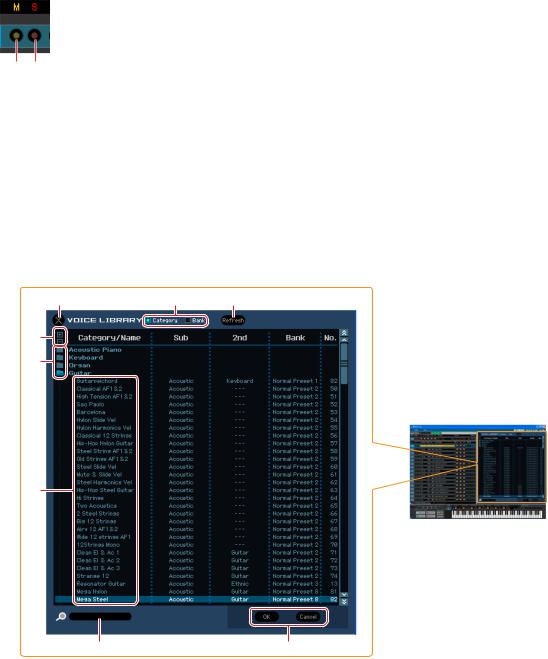
MOTIF XS Editor Window: Mixer section
Part (Part number)
Indicates the Part number. Clicking here turns the corresponding Part on.
nEven if the Editor is in the ONLINE status, selecting a Part number on the Editor will not change a Part number on the MOTIF XS and vice versa. When you want to match the Part number of the MOTIF XS with the one in the Editor, change the Part number via the panel controls of the MOTIF XS.
Mute/Solo
1 2
1 Mute
Sets the Mute status for each Part. Clicking “M” here changes the Mute status for all Parts simultaneously.
2 Solo
Selects the Solo part. Only one Part can be soloed at a time.
Category, Bank No. and Voice Name
Indicates the Category Bank and name of the Voice assigned to each Part. When clicking here, the VOICE LIBRARY window appears at the right half section, letting you select a different Voice for the current Part.
VOICE LIBRARY window
1 |
2 |
8 |
3
4
5
6 |
7 |
1Close button
Click this to close this window without applying the changes to the MOTIF XS Editor.
2[Category]/[Bank] checkboxes
Click either of these boxes to determine whether the Voices listed here are divided into Category folders or Bank folders.
3[+]/[–] buttons
Click the [+] button to open all the folders so that all Voices appear in all folders. Click the [–] button to close all folders.
MOTIF XS Editor Owner’s Manual |
12 |
|
|
